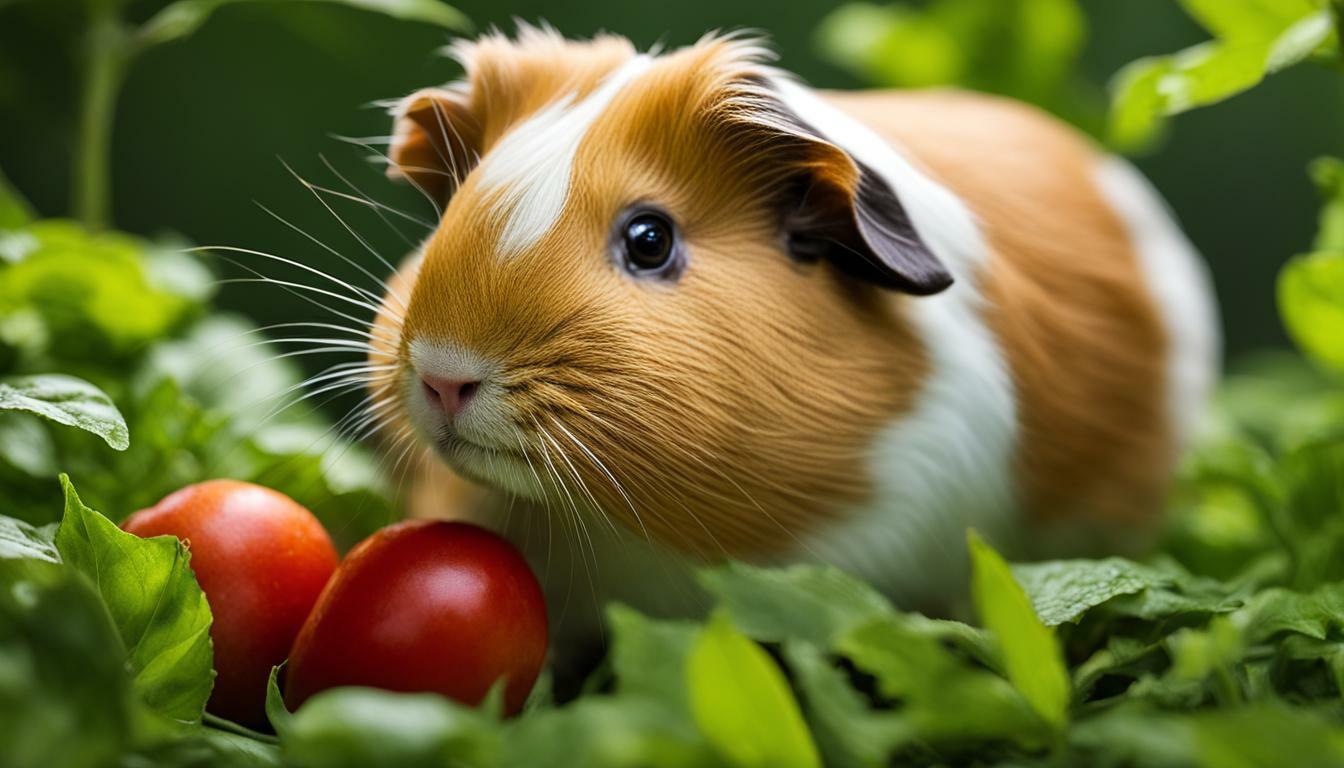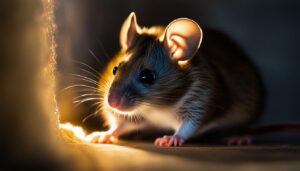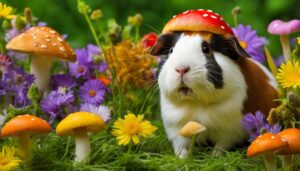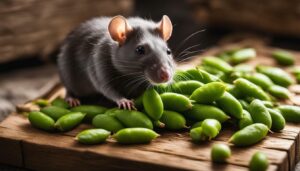Guinea pigs have specific dietary requirements, and it’s essential to understand what foods they can safely eat, including tree leaves. While some tree leaves can be beneficial for guinea pigs, it’s crucial to provide them with the right types to ensure their health and well-being. In this article, we will explore the topic of guinea pigs and tree leaves, discussing safe options, potential risks, and the role of these leaves in their overall diet.
Key Takeaways:
- Guinea pigs can safely eat certain tree leaves, including apple, banana, pear, and grape tree leaves.
- It is important to avoid toxic tree leaves such as iris, tulip, and bluebell leaves, as they can be harmful to guinea pigs.
- Oak leaves, while not toxic, contain high levels of tannins and can cause gastrointestinal upset in guinea pigs.
- Feeding guinea pigs tree leaves can provide them with essential nutrients like vitamins A and C, fiber, and antioxidants.
- However, it’s crucial to avoid overfeeding tree leaves to guinea pigs to prevent health issues such as urinary problems and upset stomach.
Guinea Pig Diet: A Comprehensive Guide
Proper nutrition is crucial for the health and well-being of guinea pigs, and understanding their dietary needs is key to providing them with a balanced diet. When it comes to feeding guinea pigs, it’s important to offer a variety of foods that meet their nutritional requirements. In addition to hay and fresh vegetables, tree leaves can be included in their diet.
Safe tree leaves for guinea pigs include apple, banana, pear, and grape tree leaves. These leaves provide essential nutrients such as vitamins A and C, fiber, and antioxidants. However, it’s important to remember that not all tree leaves are safe for guinea pigs to consume. Toxic leaves such as iris, tulip, or bluebell leaves should be avoided, as they can be harmful to their health.
The Role of Tree Leaves in a Guinea Pig’s Diet
Tree leaves play a significant role in a guinea pig’s diet by providing them with additional nutrients and variety. Including tree leaves in their diet can help prevent boredom and encourage natural foraging behaviors. It’s important to offer a balanced combination of tree leaves, hay, fresh vegetables, and a small amount of pellets to ensure they receive all the necessary nutrients.
| Safe Tree Leaves | Toxic Tree Leaves |
|---|---|
| Apple | Iris |
| Banana | Tulip |
| Pear | Bluebell |
| Grape |
While oak leaves are not toxic to guinea pigs, they contain high levels of tannins that can cause gastrointestinal upset. It’s best to avoid feeding oak leaves to guinea pigs to prevent any potential health issues. Additionally, it’s important to avoid overfeeding tree leaves, as excessive amounts can lead to urinary issues, upset stomach, and other health problems.
In conclusion, including safe tree leaves in a guinea pig’s diet can provide them with essential nutrients and variety. However, it’s crucial to feed them the right types and avoid toxic or potentially harmful leaves. Remember to offer a balanced diet that includes tree leaves, hay, fresh vegetables, and a small amount of pellets to ensure their overall health and well-being.
The Role of Tree Leaves in a Guinea Pig’s Diet
Tree leaves can be a beneficial addition to a guinea pig’s diet, providing them with essential nutrients and dietary variety. While guinea pigs primarily rely on hay as their main source of fiber, incorporating tree leaves into their diet can offer additional nutritional benefits. Leafy greens, such as apple, banana, pear, and grape tree leaves, are safe for guinea pigs to consume and can contribute to their overall well-being.
These tree leaves are rich in vitamins A and C, which are essential for guinea pigs’ growth and maintenance of their immune system. Additionally, tree leaves are a great source of fiber, promoting healthy digestion and preventing gastrointestinal issues. The presence of antioxidants in tree leaves can also help protect guinea pigs from the harmful effects of free radicals.
However, it’s important to exercise moderation when feeding tree leaves to guinea pigs. While they offer nutritional benefits, overfeeding leaves can lead to health problems such as urinary issues and upset stomach. Therefore, it is recommended to provide a balanced diet that includes a variety of foods, such as hay, fresh vegetables, a small amount of pellets, and occasional tree leaves.
| Safe Tree Leaves for Guinea Pigs |
|---|
| Apple tree leaves |
| Banana tree leaves |
| Pear tree leaves |
| Grape tree leaves |
On the other hand, there are tree leaves that should be avoided as they can be toxic to guinea pigs. Leaves of plants such as iris, tulip, and bluebell are not safe for consumption and should be kept away from guinea pigs.
In conclusion, tree leaves can be a valuable addition to a guinea pig’s diet, providing essential nutrients and dietary variety. However, it’s crucial to feed them appropriate tree leaves and to avoid overfeeding. By offering a balanced diet that includes a mix of hay, fresh vegetables, and a small amount of pellets alongside the occasional treat of safe tree leaves, you can ensure your guinea pigs’ nutritional needs are met for optimal health and well-being.
Safe Tree Leaves for Guinea Pigs
Not all tree leaves are safe for guinea pigs to eat, but there are several types that can be included in their diet without any harm. It’s important to provide guinea pigs with a varied diet that includes safe tree leaves, along with other nutritious foods such as hay, fresh vegetables, and a small amount of pellets.
Safe tree leaves for guinea pigs include apple, banana, pear, and grape tree leaves. These leaves are not only safe for consumption but also provide essential nutrients that contribute to a balanced diet for guinea pigs. They are rich in vitamins A and C, fiber, and antioxidants, which are all beneficial for their overall health and well-being.
When introducing tree leaves into your guinea pig’s diet, it’s crucial to do so in moderation. Excessive amounts of tree leaves can lead to urinary issues, upset stomach, and other health problems. It’s recommended to offer tree leaves as a treat or supplement to their regular diet rather than as the main source of nutrition.
| Safe tree leaves for guinea pigs | Nutritional Benefits |
|---|---|
| Apple tree leaves | Rich in vitamins A and C |
| Banana tree leaves | High in fiber and antioxidants |
| Pear tree leaves | Nutrient-dense and a source of fiber |
| Grape tree leaves | Contain essential vitamins and minerals |
In conclusion, including safe tree leaves in a guinea pig’s diet can provide them with additional sources of nutrition and enrichment. As responsible pet owners, it’s important to ensure a balanced diet for our furry friends, incorporating a variety of safe foods, including tree leaves, to promote their overall health and well-being.
Toxic Tree Leaves to Avoid
Some tree leaves can be toxic to guinea pigs and should never be included in their diet to ensure their safety. These toxic leaves can cause severe health problems and even be fatal if ingested by guinea pigs. It is essential to be aware of these leaves and ensure they are kept far away from your furry friend.
Toxic tree leaves that should be avoided include iris, tulip, and bluebell leaves. These leaves contain substances that are harmful to guinea pigs and can lead to digestive issues, organ damage, or even poisoning. It’s crucial to be vigilant and prevent your guinea pig from having access to these toxic leaves.
To ensure your guinea pig stays healthy, it is recommended to create a safe and balanced diet for them. This includes offering safe tree leaves, such as apple, banana, pear, and grape tree leaves. These leaves provide vital nutrients like vitamins A and C, fiber, and antioxidants, which are beneficial for your guinea pig’s overall well-being.
| Toxic Tree Leaves | Safe Tree Leaves |
|---|---|
| Iris | Apple |
| Tulip | Banana |
| Bluebell | Pear |
| Grape |
However, it’s crucial to remember that moderation is key when feeding tree leaves to guinea pigs. Overfeeding leaves can lead to urinary issues, upset stomach, and other health problems. It’s best to offer a varied diet that includes hay, fresh vegetables, and a small amount of pellets in addition to tree leaves to provide your guinea pig with the necessary nutrition they need.
Oak Leaves: Potential Risks for Guinea Pigs
While oak leaves are not necessarily toxic to guinea pigs, their high tannin content can lead to gastrointestinal issues if consumed in large quantities. It’s important to exercise caution when offering oak leaves to your furry friends. While some guinea pigs may enjoy nibbling on oak leaves without any adverse effects, others may experience digestive upset if they consume too much.
Tannins are naturally occurring compounds found in many plants, including oak trees. These compounds can cause irritation to the gastrointestinal system and can lead to symptoms such as diarrhea, bloating, and discomfort. If you choose to feed your guinea pigs oak leaves, it’s essential to introduce them gradually and in small quantities to monitor their response.
Table: Safe Tree Leaves for Guinea Pigs
| Tree Leaves | Safety |
|---|---|
| Apple tree leaves | Safe |
| Banana tree leaves | Safe |
| Pear tree leaves | Safe |
| Grape tree leaves | Safe |
Remember that guinea pigs require a balanced diet, with a variety of foods to ensure they receive all the necessary nutrients. While tree leaves can be a part of their diet, they should not be the sole source of nutrition. A diet rich in hay, fresh vegetables, and a small amount of pellets is crucial to maintaining your guinea pig’s overall health and well-being.
If you are unsure about whether a particular tree leaf is safe for your guinea pig, it’s always best to consult with a veterinarian. They can provide guidance on the suitability of specific leaves and any potential risks associated with them. By feeding your guinea pigs a well-rounded and balanced diet, you can help ensure their happiness and longevity.
Nutritional Benefits of Feeding Tree Leaves to Guinea Pigs
Feeding tree leaves to guinea pigs can offer valuable nutrients that contribute to their overall health and well-being. These leafy greens are a great source of essential vitamins and minerals, including vitamins A and C. These vitamins are important for guinea pigs as they support their immune system, maintain healthy skin and fur, and promote proper growth and development.
In addition to vitamins, tree leaves also provide guinea pigs with dietary fiber. Fiber is crucial for maintaining a healthy digestive system and preventing gastrointestinal issues. By including tree leaves in their diet, guinea pigs can enjoy the benefits of improved digestion and regular bowel movements.
Table: Nutritional Content of Common Tree Leaves
| Tree Leaf | Key Nutrients |
|---|---|
| Apple Leaves | Vitamin C, Fiber, Antioxidants |
| Banana Leaves | Fiber, Potassium, Vitamin B6 |
| Pear Leaves | Vitamin C, Vitamin K, Fiber |
| Grape Leaves | Vitamin A, Vitamin C, Fiber |
It’s important to note that guinea pigs should be fed tree leaves in moderation. While these leaves are nutritious, they should not make up the majority of their diet. A balanced diet for guinea pigs includes a variety of foods, such as hay, fresh vegetables, and a small amount of pellets. By offering a diverse range of foods, you can ensure that your guinea pig receives all the nutrients they need for optimal health.
Lastly, always remember to thoroughly wash tree leaves before feeding them to your guinea pig. This removes any potential pesticides or dirt that may be present on the leaves. Providing clean, fresh tree leaves will help keep your guinea pig happy, healthy, and satisfied.
Moderation is Key: Overfeeding Tree Leaves
While tree leaves can be a healthy addition to a guinea pig’s diet, it’s crucial to avoid overfeeding them to prevent urinary issues, upset stomach, and other health problems. Guinea pigs have sensitive digestive systems, and consuming excessive amounts of leaves can lead to gastrointestinal discomfort. To ensure the well-being of your furry friend, it’s important to understand the importance of moderation when it comes to feeding tree leaves.
When introducing tree leaves into your guinea pig’s diet, start with small portions and gradually increase the amount over time. This allows their digestive system to adjust and helps prevent any sudden stomach upset. Remember, variety is key, so it’s advisable to offer a mix of different safe leaves, such as apple, banana, pear, and grape tree leaves, to ensure your guinea pig receives a diverse range of nutrients.
Monitoring your guinea pig’s intake is essential. Observe their eating habits and behavior to ensure they are not consuming an excessive amount of tree leaves. Signs of overfeeding may include changes in appetite, diarrhea, or a decrease in water consumption. If you notice any of these signs, it’s important to reduce the amount of leaves you are offering and consult with a veterinarian if necessary.
| Safe Tree Leaves | Amount to Feed |
|---|---|
| Apple Tree Leaves | A few leaves per day |
| Banana Tree Leaves | A few leaves per day |
| Pear Tree Leaves | A few leaves per day |
| Grape Tree Leaves | A few leaves per day |
Remember, a guinea pig’s diet should consist primarily of hay, supplemented with fresh vegetables and a small amount of pellets. Tree leaves should only make up a small portion of their daily food intake. By providing a balanced diet and practicing moderation with tree leaves, you can ensure that your guinea pig receives the nutrition they need for a healthy and happy life.
Creating a Balanced Diet for Guinea Pigs
A balanced diet is essential for guinea pigs, and combining tree leaves with other key food groups can help ensure their nutritional needs are met. When it comes to feeding your guinea pig tree leaves, it’s important to choose the right ones. Safe tree leaves for guinea pigs include apple, banana, pear, and grape leaves, which can provide them with essential vitamins and fiber.
However, it’s crucial to be aware of toxic leaves that should be avoided. Certain leaves, such as iris, tulip, and bluebell leaves, can be harmful to guinea pigs if ingested. Oak leaves, while not toxic, contain high levels of tannins that can cause gastrointestinal upset. It’s best to steer clear of these leaves to ensure the health and well-being of your guinea pig.
When feeding tree leaves to your guinea pig, it’s important to do so in moderation. While leaves can offer valuable nutrients, overfeeding can lead to urinary issues, upset stomach, and other health problems. Alongside tree leaves, it’s important to provide a varied diet consisting of high-quality hay, fresh vegetables, and a small amount of pellets. This combination will help ensure that your guinea pig receives the proper balance of nutrients for optimal health.
| Safe Tree Leaves for Guinea Pigs | Toxic Tree Leaves to Avoid |
|---|---|
| Apple leaves | Iris leaves |
| Banana leaves | Tulip leaves |
| Pear leaves | Bluebell leaves |
| Grape leaves |
By providing your guinea pig with a balanced diet that includes tree leaves in moderation, you can help support their overall health and well-being. Remember to consult with a veterinarian or guinea pig specialist for specific dietary recommendations based on your pet’s individual needs. With proper nutrition and care, your guinea pig will thrive and bring joy to your life.
Providing Optimal Nutrition for Your Guinea Pig
Ensuring your guinea pig receives optimal nutrition is crucial for their overall well-being, and following these guidelines can help you meet their dietary needs. A balanced diet is essential, and incorporating a variety of foods will provide your furry friend with the necessary nutrients for a healthy life.
When it comes to tree leaves, it’s important to know which ones are safe for guinea pigs to consume. Apple, banana, pear, and grape tree leaves are among the safe options that can be included in their diet. These leaves not only provide a tasty treat for your guinea pig but also offer essential vitamins A and C, fiber, and antioxidants.
However, it’s crucial to avoid overfeeding tree leaves to your guinea pig. Excessive amounts can lead to urinary issues, upset stomach, and other health problems. Moderation is key, and it’s best to offer tree leaves as part of a balanced diet that also includes hay, fresh vegetables, and a small amount of pellets.
| Safe Tree Leaves for Guinea Pigs | Toxic Tree Leaves to Avoid |
|---|---|
| Apple | Iris |
| Banana | Tulip |
| Pear | Bluebell |
| Grape |
Remember to always research and consult with a veterinarian to ensure the safety of any new foods you introduce to your guinea pig’s diet. By providing a balanced and varied diet, you can help keep your guinea pig happy and healthy for years to come.
Conclusion
By understanding the dietary needs of guinea pigs and carefully selecting tree leaves and other appropriate foods, you can ensure their health and happiness as a responsible pet owner.
Guinea pigs can safely consume certain tree leaves, such as apple, banana, pear, and grape tree leaves, which offer essential nutrients like vitamins A and C, fiber, and antioxidants. These leaves can be a valuable addition to their diet, but it’s crucial to avoid toxic leaves like iris, tulip, or bluebell leaves, as they can be harmful to their health.
However, it’s important to note that oak leaves, although not toxic, can cause gastrointestinal upset in guinea pigs due to their high tannin content. Therefore, it’s best to refrain from feeding oak leaves to your guinea pig to prevent any potential health issues.
While tree leaves can provide nutritional benefits, it’s essential to remember that moderation is key. Overfeeding tree leaves or any other food can lead to urinary issues, upset stomach, and other health problems. It’s recommended to provide a balanced diet for your guinea pig, consisting of hay, fresh vegetables, a small amount of pellets, and occasional tree leaves.
By following these guidelines and maintaining a well-rounded diet, you can ensure that your guinea pig receives the necessary nutrients and stays healthy. Always monitor their eating habits, and consult a veterinarian if you have any concerns or questions about their specific dietary needs.
FAQ
Can guinea pigs eat tree leaves?
Yes, guinea pigs can eat certain tree leaves. However, it’s important to feed them the right types of leaves.
What tree leaves are safe for guinea pigs?
Safe tree leaves for guinea pigs include apple, banana, pear, and grape tree leaves.
Are there any toxic tree leaves that guinea pigs should avoid?
Yes, guinea pigs should avoid toxic tree leaves such as iris, tulip, or bluebell leaves.
Can guinea pigs eat oak leaves?
Oak leaves are not toxic to guinea pigs but can cause gastrointestinal upset due to their high tannin content.
What are the nutritional benefits of feeding tree leaves to guinea pigs?
Feeding tree leaves to guinea pigs can provide them with essential nutrients such as vitamins A and C, fiber, and antioxidants.
Can overfeeding tree leaves be harmful to guinea pigs?
Yes, overfeeding tree leaves can lead to urinary issues, upset stomach, and other health problems in guinea pigs. Moderation is key.
What should a balanced diet for guinea pigs include?
A balanced diet for guinea pigs should include a variety of hay, fresh vegetables, a small amount of pellets, and occasional tree leaves.
How can I provide optimal nutrition for my guinea pig?
Along with a balanced diet, it’s important to practice portion control, introduce new foods gradually, and monitor your guinea pig’s overall health.




